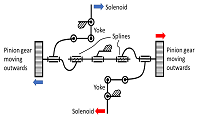Optimizing Engine Start Systems with Application to Sailing/Coasting and Mild Hybridization
DOI:
https://doi.org/10.46604/aiti.2020.4148Keywords:
start/stop, mild hybrid, silent start, sailing/coastingAbstract
Engine start systems are key to providing a good customer experience for today’s drivers. Considerable effort goes into ensuring a smooth and quiet engine start, especially in vehicles equipped with start/stop systems. We present two novel mechatronic starters that are designed to improve start quality by enabling faster and quieter engine starts. In the first proposed concept, the traditional alternator is replaced with a motor/generator unit that is capable of exerting positive torque on the engine as needed, in addition to the conventional power generation function. The motor/generator is selectively connected to the crankshaft via a selectable geared or belted connection to enable different operating modes. This starter executes a 400 ms faster start for a typical engine when compared to a conventional 12V starter. We also present a second starter that uses an integrated two-speed gear train to crank the engine. The cranking gear ratio is changed from the initial high ratio to a lower ratio once the engine starts to spin. This ratio change allows the starter motor to continue to operate in a favorable torque-speed zone and push the engine to a higher pre-ignition rpm than a conventional starter, resulting in a quieter, smoother start.
We also present results from incorporating the belted/geared starter concept in vehicles with sailing/coasting mode as well as in mild hybrid propulsion systems. Sailing/coasting mode of operation is enabled by the quick engine re-start capability of this starter allowing seamless switching between fuelled and unfuelled engine operation. Such an operation could reduce fuel consumption by about 3-6% on the NEDC driving cycle, without regenerative braking. One may further hybridize the propulsion system by adding a battery for storing regenerative braking energy. Using such an architecture, a 6-8% fuel economy improvement on the WLTP certification driving cycle may be achieved, depending on voltage and power levels implemented, as well as energy storage systems included.
References
D. Greene and S. Plotkin, “Reducing greenhouse gas emissions from U.S. transportation,” Pew Center on Global Climate Change, pp. 1-80, May 2003.
T. Wellmann, K. Govindswamy, and D. Tomazic, “Integration of engine start/stop systems with emphasis on NVH and launch behavior,” in SAE Technical Paper 2013-01-1899.
J. Storey, M. Moses-DeBusk, S. Huff, J. Thomas, M. Eibl, and F. Li, “Characterization of GDI PM during vehicle start-stop operation,” in SAE Technical Paper 2019-01-0050.
Z. Xu, N. Tao, M. Du, T. Liang, and X. Xia, “Damage prediction for the starter motor of the idling start-stop system based on the thermal field,” in SAE International Journal of Commercial Vehicles. 10(2):2017, 2017-01-9181.
J. Wishart, M. Shirk, T. Gray, and N. Fengler, “Quantifying the Effects of Idle-Stop Systems on Fuel Economy in Light-Duty Passenger Vehicles,” in SAE Technical Paper 2012-01-0719.
A. Inglis, R. Timewell, and S. Maskerine, “A novel compressed air starting system,” in SAE Technical Paper 2003-01-2279.
N. Henein, D. Taraza, N. Chalhoub, M. Lai, and W. Bryzik, “Exploration of the contribution of the start/stop transients in HEV operation and emissions,” in SAE Technical Paper 2000-01-3086.
T. Costlow, “Powering up the new stop-start systems,” Automotive Engineering, June 2016.
N. Fonseca, J. Casanova, and M. Valdes, “Influence of the stop/start system on CO2 emissions of a diesel vehicle in urban traffic,” Transportation Research Part D: Transport and Environment, vol. 16, no. 2, pp. 194-200, March 2011.
G. Tamai, T. Hoang, J. Taylor, C. Skaggs, and B. Downs, “Saturn Engine Stop-Start System with an Automatic Transmission,” SAE Transactions, vol. 110, pp. 270-280, 2001.
M. Canova, Y. Guezennec, and S. Yurkovich, “On the control of engine start/stop dynamics in a hybrid Electric vehicle,” ASME Journal of Dynamic Systems Measurement and Control, vol. 131, no. 6, pp. 1-12, November 2009.
M. Raghavan and A. Balhoff, “Electrical torque addition mechanism for engines with high levels of EGR,” in EuCoMeS 2018: Proceedings of the 7th European Conference on Mechanism Science, edited by Burkhard Corves, Philippe Wenger, Mathias Hüsing, 2018, pp. 165-172.
M. Raghavan, “Mild electrification across a spectrum of vehicle types,” in FISITA Technical Paper No. F2018-EHV-009, 2018.
M. Raghavan, N. Bucknor, and V. Donikian, “The kinematics and dynamics of engine start systems,” in IFToMM Asian MMS Conference, Bangalore, 2018.
M. Raghavan, “Novel mechanisms to improve the start quality of automotive engines,” in IFToMM World Congress, Krakow, 2018.

Published
How to Cite
Issue
Section
License
Submission of a manuscript implies: that the work described has not been published before that it is not under consideration for publication elsewhere; that if and when the manuscript is accepted for publication. Authors can retain copyright in their articles with no restrictions. is accepted for publication. Authors can retain copyright of their article with no restrictions.
Since Jan. 01, 2019, AITI will publish new articles with Creative Commons Attribution Non-Commercial License, under The Creative Commons Attribution Non-Commercial 4.0 International (CC BY-NC 4.0) License.
The Creative Commons Attribution Non-Commercial (CC-BY-NC) License permits use, distribution and reproduction in any medium, provided the original work is properly cited and is not used for commercial purposes.







